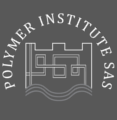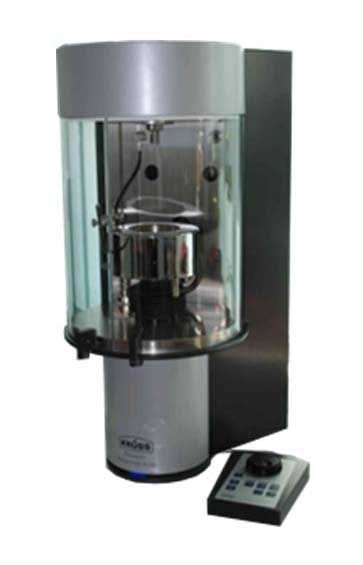Equipment DCM
NEXSA-G2, Monochromated high-performance XPS spectrometer
Thermo Scientific, UK
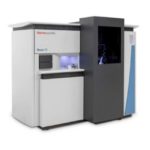
In X-ray Photoelectron Spectroscopy (XPS) we are concerned with a special form of photoemission, i.e., the ejection of an electron from a core level by an X-ray photon of energy hv. The energy of the emitted photoelectrons is then analysed by the electron spectrometer and the data presented as a graph of intensity (usually expressed as counts or counts/s) versus electron energy – the Xray induced photoelectron spectrum. XPS is a surface sensitive technique, since the depth from which information can be derived is a few nanometers (2-10 nm). In our laboratory we are performing surface analysis of solid samples (plates, films, powders) of the size up to 60 x 60 x 20 mm (width x length x height).
More about the XPS Spectroscopy lab you can find on www.polymer.sav.sk/dcm-xps
Specification:
Micro-focused, monochromated Al K-α X-ray source, Adjustable from 10-400 μm
Multichannel detector with 128 channels (with „snap-shot“ aquisition mode for XPS imaging)
Flood gun for the charge compensation (measurement of insulating samples)
Ion gun MAGCIS for depth profiling for dual mode monatomic & gas cluster ion source
Angle resolved XPS (ARXPS)
Ion scattering spectroscopy (ISS)
UV photoelectron spectroscopy (UPS)
Reflected electron energy loss spectroscopy (REELS)
Fully automated (automated entry lock and sample transfer, safety interlocked, turbomolecular pumped loadlock, data acquisition, data processing, report generation, auto analysis mode of operation)
Broadband Dielectric Spectrometer Concept 40
Novocontrol, Germany

This is our high end system for the frequency range from 3 μHz – 20 MHz (12.5 decades) based on the Alpha-A modular measurement system for dielectric, conductivity, electrochemical and impedance spectroscopy with several test interfaces. The sample impedance is directly determined by the phase-sensitive measurement of the sample voltage and current at fixed frequency. In combination with the ZGS active sample cell interface, the standard sample arrangement is a parallel plate capacitor with diameters from 40 mm to 10 mm and a spacing between the plates from 20 mm to 10 μm.
Specification:
Frequency: 3.10-5 .. 2.107 Hz
Capacity: 10-15 .. 1 F
Impedance: 0.01 – 1014 Ω
Loss factor tan(δ): accuracy < 3.10-5, resolution 10-5
Nanoindentor Hysitron TI 750 Ubi
Hysitron, USA

The TI 750 Ubi nanomechanical test instrument is a dedicated scanning nanoindenter. Its top-quality, robust and compact design combined with Hysitron’s exclusive in-situ SPM imaging capability and performech control unit makes it superior in both function and performance. This affordable stand-alone nanomechanical test instrument is capable of performing a variety of quasi-static nanoindentation with upgradeable automation and nanoscratch capabilities. The direct coupling of Hysitron’s patented three-plate capacitive transducer to an SPM piezo scanner enables true in-situ SPM imaging of the test surface immediately before and after the indentation test, eliminating the need for switching the heads or translating of the sample stage. The nanometer resolution in-situ imaging, tip positioning abilities, increased senstivity and feedback rate of the TI 750 Ubi with the performech control unit assist in the research of low displacement, high-resolution testing.
Specification:
Maximum Force: 10 mN
Load Resolution: <1nN
Load Noise Floor: <30nN
Maximum Depth: 5.20µm
Disp. Resolution: 0.04nm
Disp. Noise Floor: <0.2nm
Thermal Drift: <0.05nm/sec
Digital Microscope Leica DVM6
Leica Microsystems

Digital microscope Leica DVM6 with objective PlanAPO FOV 12.55 with big magnification range (40x – 675x) at a high working distance (33 mm). Fast magnification change, thanks to a wide 16:1 zoom range. High-resolution 10-megapixel camera taking images in best resolution with top-notch optics. Intelligent LAS X software – a measurement tool for every need with one click report for 2D and 3D measurements. Reproducible results easily by system settings always saved with every image, e.g., position, magnification, illumination.
Specification:
Contact angle measurement system OCA 25
Dataphysics, Germany
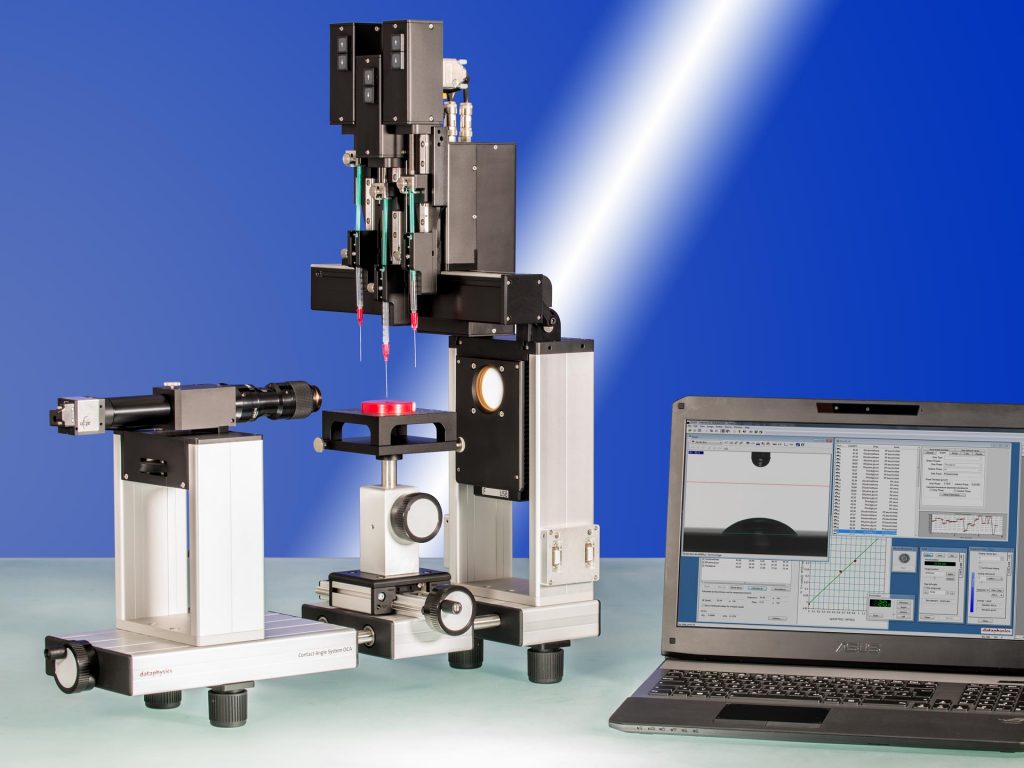
The OCA 25 is the device for contact angle measurements and droplet shape analysis. The sample table of the OCA 25 is adjustable along all three directions in space via precision axes with hand wheels. The device allows measurement of geometric contact angles as well as the contact angle hysteresis using sessile drop method and measurement of the surface tension and the interfacial tension using pendant drop method. Included software allows analysis of the drop shape by 5 different methods as well as the determination of the surface energy and the work of adhesion on the basis of various calculation methods.
Specification:
sample holder adjustable in all three axis with precision mechanics
high performance 6.5-fold optical zoom lens (0.7 – 4.5-fold magnification) with integrated focus (± 6 mm) and adjustment of the observation angle (-4° .. +5°); working distance 87.2mm
Measuring range for contact angles: 0…180°; ± 0.1°
Integrated continuous fine focus, and adjustable observation angle
Video measuring system with high-performance camera using USB 3.0 interface; max. pixel 768 x 576 resolution; max. sample rate 123 images/s
LED-lighting with manual and software controlled adjustable intensity
Minimal dosing volume: 10 nl
Nicolet iS20 Mid-Infrared FT-IR Spectrometer
Thermo Scientific, UK
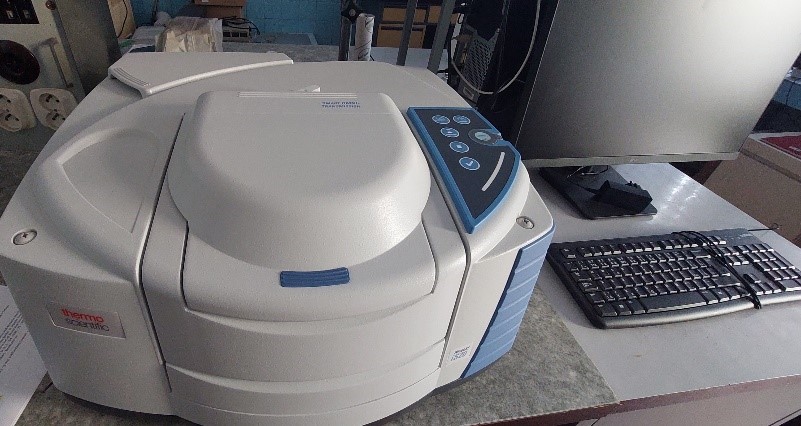
The Thermo Scientific Nicolet iS20 FTIR Spectrometer is equipped with ZnSe Crystal Plate for Smart iTX and iD7 ATR. An integrated touch panel allows to quickly analyse samples and a multi-color LED scan bar gives users immediate feedback on whether the instrument is in idle, collect or alert mode.
Specification:
Single-point source with non-migrating hotspot
Interferometer with KBr/Ge coated beamsplitter and dynamic alignment, 7800-350 cm-1
Solid-state, temperature controlled diode laser
High-performance, fast-recovery DTGS detector
Integrated touch panel with capacitive touch workflow buttons and multi-colored LED scan bar to provide real-time instrument feedback
1 min signal to noise of better than 50,000:1
0.25 cm-1 standard resolution (variable from 64 to 0.25 cm-1)
Rapid Scan Capability
Sealed and desiccated with BaF2 coated, KBr windows
Metal case desiccant canister (regenerable), and humidity indicator
Autoalign energy optimization
Potentiostat Galvanostat SP-200
Bio-Logic Science Instruments
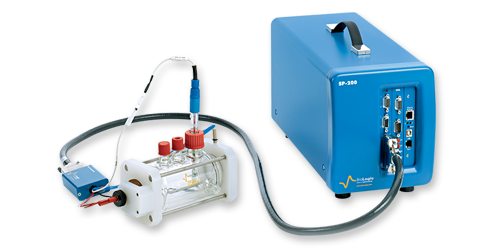
SP-200 is the newest, research grade, value-oriented potentiostat / galvanostat in the Bio-Logic product range.
With excellent specifications in a portable chassis, the SP-200 is the perfect instrument for any application in electrochemistry especially in corrosion.
The SP-200 offers outstanding features such as a floating mode, analog filtering, a built-in calibration board, and 9 stability bandwidths for a better control of the cell.
SP-200 offers measurement with a standard DC potentiostat or an EIS capable one. There is also an Ultra Low Current (ULC) option.
Specification:
Compliance: ±12 V
Control voltage: ±10 V
EIS measurement: 3 MHz (1%, 1°) 7 MHz (3%, 3°)
Current ranges: 500 mA to 1 µA (10 nA with gain)
Current resolution 760 fA (standard board)
Low current: 6 ranges from 100 nA to 1 pA with resolution to 76 aA
Floating mode
Analog filtering
Calibration board
Full stability control mode (9 bandwidths)
Dynamic Mechanical Analyser DMA Q800
TA Instruments
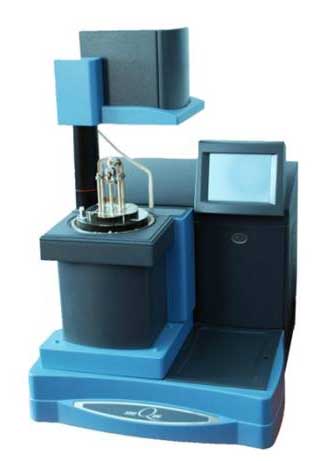
Dynamic mechanical analysis (DMA) is a linear viscoelastic technique, which is useful for determining such important mechanical properties as loss factor, storage and loss moduli under sinusoid deformation. It is a mainstream characterization technique for polymers to determine transition temperatures, physical ageing, degradation of polymers, miscibility, optimal time for vulcanization etc.
Specification:
Force range: 0.0001 N to 18 N
Amplitudes in a dynamic experiment: 0.5μm to 10,000 μm
Frequency range: 0.01 to 200 Hz.
Modular Compact Rheometer Anton Paar MCR 702
Anton Paar GmbH, Austria
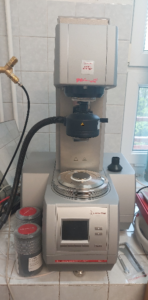
Modular rotational rheometer enabling measurement in rotation and oscillation equipped with the patented TruGap™, T-Ready™ and ToolmasterTM technology automatically recognizes measuring systems.
Designed for rheological analysis with the possibility of completing DMA measurements (tension, torsion, compression, bending). The fully computer-controlled system with software that allows all measurements, templates, and configuration data to be stored in a central database to ensure data security and integrity.
Possibility for managing the experiment workflow in the RheoCompass software by selecting the various customized test templates and predefined analysis. Modular system is equipped with an electronic motor lock that facilitates the removal of an excess sample before measurement without the need for mechanical bearing locking. Excellent device for sophisticated evaluation of viscoelastic properties of polymer melts, solutions, suspension, and gels
Specification:
Minimum oscillation torque ≤ 0.5 nNm.
Maximum torque ≥ 230 mNm.
Measurement of normal force in the minimum range of 0.005 to 50 N
Measurement in rotary mode with a range of angular velocities of at least 10-9 to 314 rad / s
Measurement in oscillating mode with a range of angular frequencies of min. 10-7 to 628 rad / s
Refrigerated Peltier temperature system with the possibility of temperature control from at least – 30 ° C to 200 ° C
Standard plate / plate measuring system with a diameter of 25/50 mm
Reometer AR2000
TA Instruments
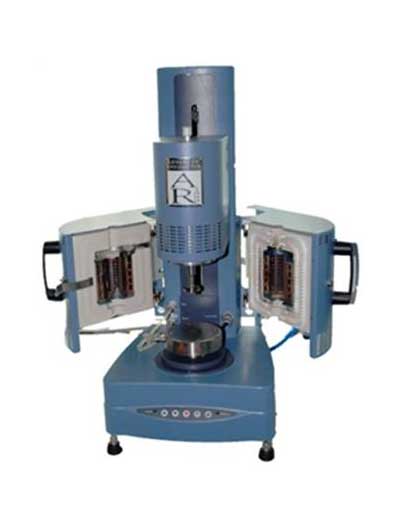
The TA Instruments AR 2000 Rheometer is a controlled stress/controlled rate rheometer capable of handling many different types of samples, using a range of geometry sizes and types.
Specification:
Torque range: 0.1 mNm to 200 mNm
Frequency range 0.12 μHz to 100 Hz
Temperature range: 0°C to 600°C
Compounder – Plastograph with accessories
Brabender GmbH, Germany
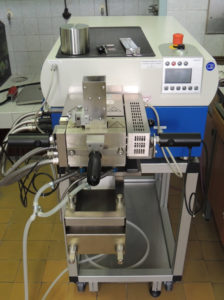
Experiments realisation:
– benchtop machine for melt blending of polymer blends and composites
Specification:
– measuring range: 0 to 200 Nm
– power: 3.8 kW
– speed range: 0,2 to 150 rpm at maximum torque
– deviation: 0,2%
The device is part of the CAV.sav.sk.
Micro-compounder DSM Xplore 15 ml
DSM Xplore, The Netherlands
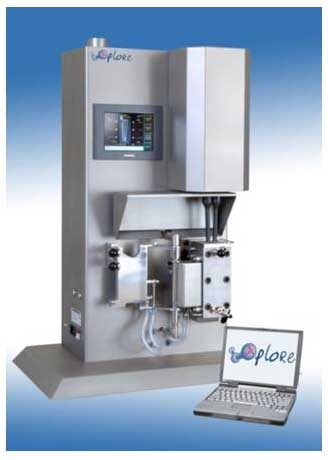
Micro-compounder serve for preparation of composites and nanocomposites based on polymer matrix by melt-mixing. As fillers various organic or inorganic materials can be used. In the compounding step, a base material is compounded with additives to form a homogeneous mixture.
Specification:
Volume of mixing chamber: 15 ml
Max. working temperature: 400 °C
Adjustable speed of rotation: 1 – 250 rpm
Max. axial force: up to 8000 N.
Max torque: 10 N / m for one screw
Plasti-corder Brabender PLE 331
Brabender, Germany
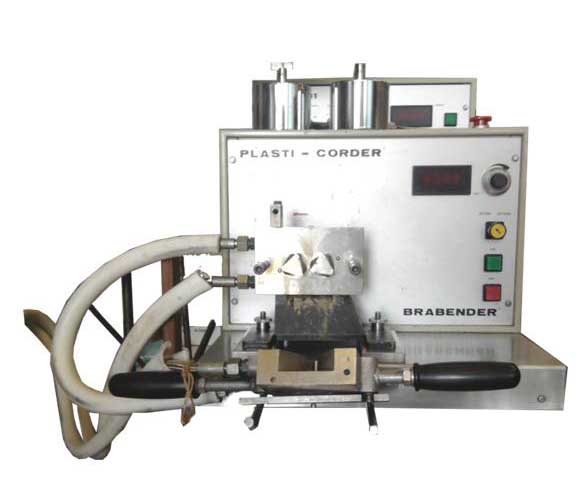
Plasti-corder Brabender is an equipment for preparing polymer composites, i.e. blends of polymers or polymers filled with inorganic or organic fillers, additives, etc. for improving properties of polymeric materials. Composites can be prepared in two chambers or continually in a twin screw extruder. Chambers are heated by silicon oil and extruder is electrically heated.
Specification:
Temperature range: 25 – 250 °C (oil heating) or 25 – 300 °C (electric heating)
Mixing rate: 0 – 120 rpm
Volume of chambers: 30ml and 50ml
Calander Nishimura
Nishimura, Tokyo, Japan
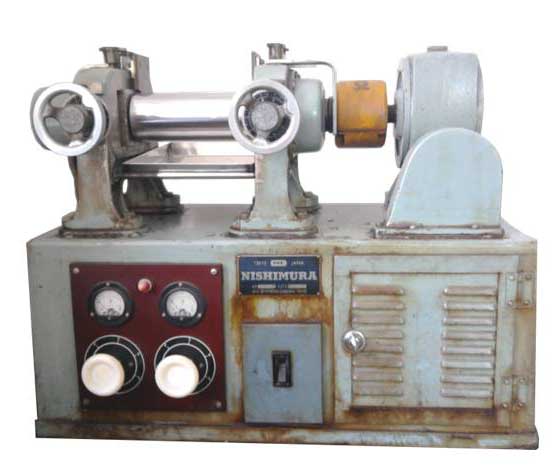
Equipment is designed for mixing of rubbers and compositions based on rubbers with different additives. It works at room temperature without heating of cylinders.
Specification:
Number of cylinders: 2
Friction ratio: 1:1,4
Performance: 0.75 kW
Laboratory press for polymer composites, LabEcon 300
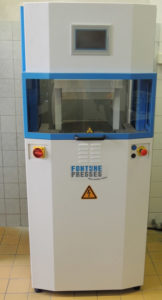
Specification:
– closing force (max.): 300 kN
– plate size: 320 x 320 mm
– cylinder stroke: 200 mm
– specific board pressure: 293 N/cm
– temperature: 300 °C
– water cooling, temperature and pressure control
The device is part of the CAR.
Hydraulic press Fontijne SRA-100
Fontijne, The Netherlands

The hydraulic press is used for molding of polymeric materials into sheets or strips. Heating temperature of pressing plates is adjusted to be higher than the melting point of the polymer. Press provides downforce setting to the desired value.
Specification:
Number of plates: 2
Temperature range: 25 – 250 °C
Maximum pressure: 100 kN (SR-100) and 50 kN (TP 50)
Cooling: by water
Dynamometer Instron 3365
Instron Corporation, USA
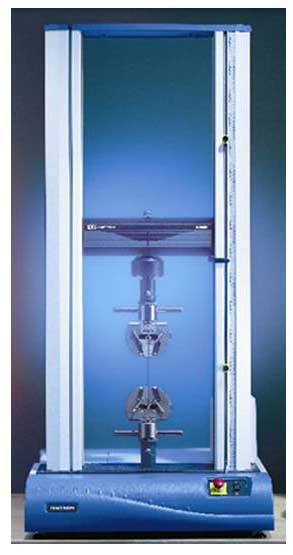
Dynamometer Instron is an equipment for testing mechanical properties of wide range of materials in tension, compression or flexure. There is a possibility to provide simple, cyclic or relax types of test.
Specification:
Load Capacity: 5 kN
Maximum speed: 1000 mm/min.
Maximum data rate: 100 pts/sec.
Dynamometer Instron 4301
Instron Corporation, USA
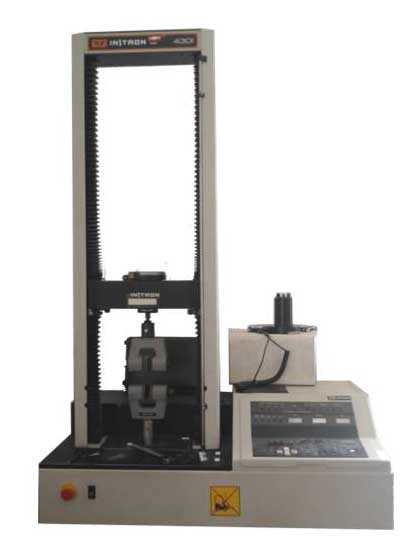
Dynamometer Instron is an equipment for testing mechanical properties of wide range of materials in tension, compression or flexure. There is a possibility to provide simple, cyclic or relax types of test.
Specification:
Load Capacity: 5 kN, 100 N
Maximum speed: 500 mm/min.
Maximum data rate: 20 pts/sec.
Dynamometer Shimadzu AGS-J
Shimadzu Corporation, Japonsko
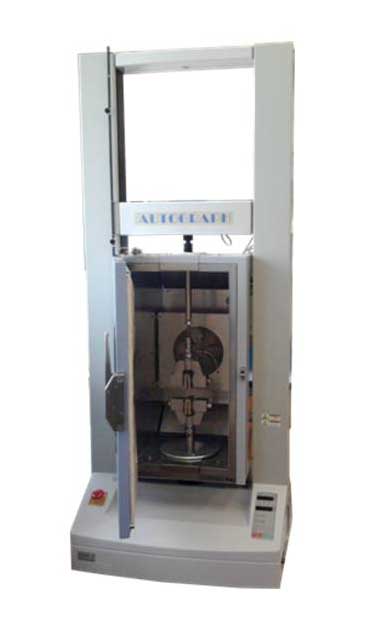
Dynamometer Shimadzu is an equipment for testing mechanical properties of wide range of materials in tension, compression or flexure. There is a possibility to provide simple, cyclic or relax types of test. There is additional equipment – thermostatic chamber TCE-N300.
Specification:
Load Capacity: 5 kN, 500 N
Speed range: 1 – 500 mm/min.
Maximum data rate: 20pts/sec.
Temperature range: – 70°C to + 280°C
Instrument for measuring impact and notch toughness of polymers and their composites CEAST, Instron, CEAST, model 9340
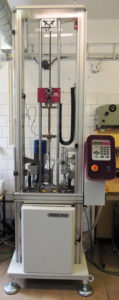
Specification:
– measuring range: 0.30 – 405 J
– impact velocity: 0.77 – 4.65 m / s
– height of the load deposition: 0.03 – 1.10 m
– mass of the weight: 1.0 – 37.5 kg
– measurement at room temperature
The device is part of the CAV.sav.sk.
Sample preparation equipment for testing mechanical properties – Pneumatic toggle press
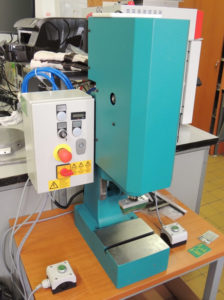
Specification:
– capacity at 6 bar: 25 kN
– working stroke: 40 mm
– Throat thickness: 130 mm
– Piston diameter: 30 mm
The device is part of the CAV.sav.sk.
Four-Point Probe System / electrical conductivity measurement
Ossila, UK
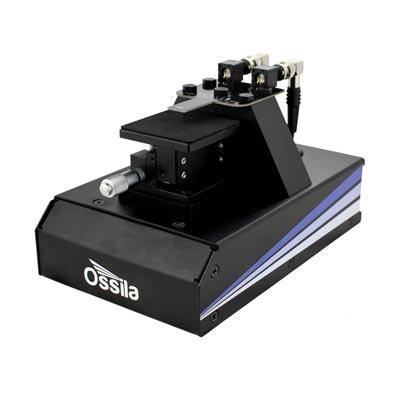
Ossila’s Four-Point Probe System is an easy-to-use tool for the rapid measurement of sheet resistance, resistivity, and conductivity of materials. The probe head uses spring-loaded contacts, preventing damage to delicate samples, such as polymer films with thicknesses on the order of nanometres. The four-point probe is capable of delivering currents between 1 µA and 150 mA and can measure voltages from as low as 100 μV up to 10 V. The system can measure sheet resistances in the range of 100 mΩ/□ to 10 MΩ/□, enabling the characterisation of a wide range of materials.
Specification:
Voltage range: ± 100 µV to ± 10 V
Current range: ± 1 µA to ± 150 mA
Sheet resistance range: 100 mΩ/□ to 10 MΩ/□ (ohms per square)
Probe spacing: 1.27 mm
Probe diameter: 0.48 mm
Maximum sample thickness: 10 mm
Sample size range: 5mm to 60 mm
Freeze-dryer Alpha 1-2 LDplus
Martin Christ Gefriertrocknungsanlagen GmbH, Germany
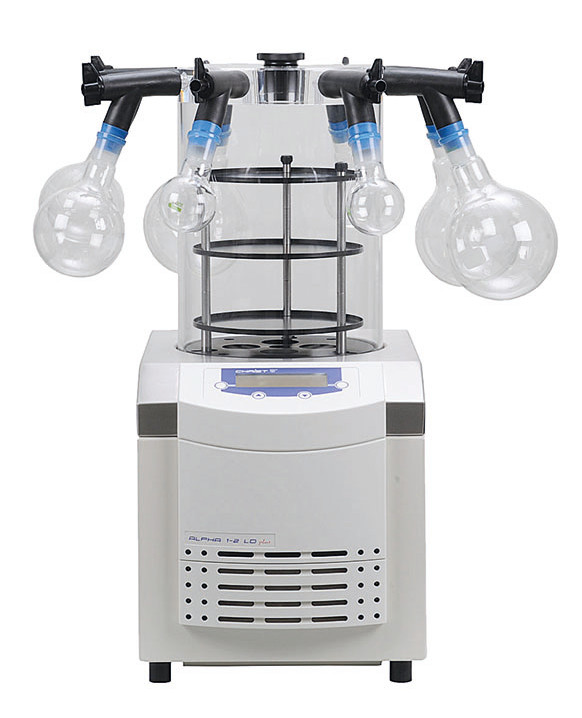
The Freeze-dryer Alpha 1-2 LDplus is a compact, high-performance table-top unit for effective lyophilisation of specimens in everyday lab activities. The LDplus user interface makes the work very easy. It is possible to choose from a wide range of configurations to adapt the freeze dryer optimally to specific needs. The condenser temperature of -55° C enables the drying of aqueous products.
Specification:
Max. capacity: 2,5 kg
Max. performance: 2 kg/14 h
Temperature (approx.): -55 °C
Electrospinning

The nanofiber technology of present interest focuses on the electrospinning technique, which conveniently allows the preparation of fibrous materials with very fine diameters ranging from submicron to several nanometres, through an electrically charged jet of polymer solutions. The basic setup consists of syringe with polymeric solution with a metallic needle tip. On the needle is connected high voltage supply. If the electrostatic force was able to overcome the surface tensions of the sample solution, the fibers are created. These are collected on the grounded metal collector, where is so called non-woven mat established.
Surface Energy Evaluation system
Advex Instruments, Czech Republic
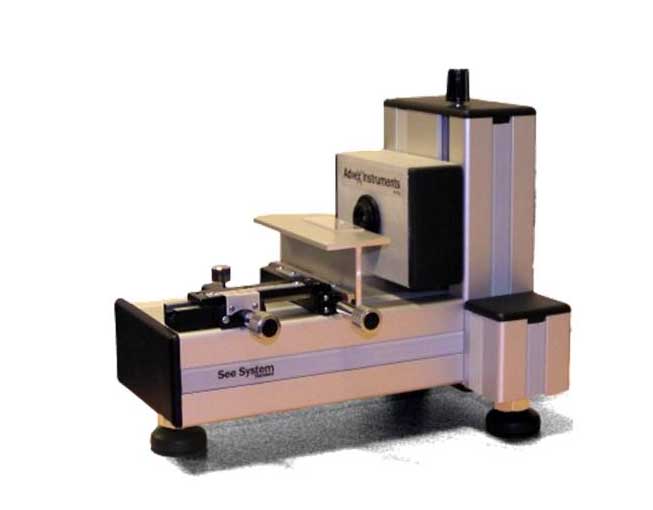
This equipment is a portable computer-based instrument designed primarily for measurement of testing liquids contact angle and determination of surface energy of polymers. It consists of rugged aluminium body, colour USB 2.0 camera with 1.3MPix resolution movable in vertical direction and 2D horizontally movable table for samples. Included software handles all operations: saving images, analysis of drop profile and of the contact angle, determination of surface energy on the basis of various calculation models.
Specification:
Dimension: 175 x 160 x 145 mm
Camera colour: 1280×960
Drop dimension range: 0.5 – 20 microliter connected through USB port
Plasma generator Low Cost System Zepto
Diener electronic GmbH, Germany
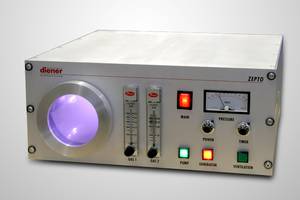
Plasma technology can be used on different materials such as glass, metal, plastics, textiles and ceramics and for different purposes such as surface cleaning, surface activation, surface etching and surface deposition – plasmapolymerization.
Organic remains are chemically transformed during the plasma process. The surface is subjected to a fine cleaning. Nearly all materials can be cleaned with an oxygen plasma.
Plasma activation is used to transform non-polar surfaces such as plastics (PDMS, PE, PP, …) into adhesive surfaces. The surface energy is increased without damaging the material’s properties.
Teflon surfaces must be etched in order to become hydrophilic. Plasma etching is performed without aggressive chemicals.
Monomers with a suitable vapor pressure are implemented and used to produce various effects on the surface.
Specification:
Generator: 13.56 MHz, 0 – 50 W
Vacuum chamber: round, borosilicate glass, cap, Ø approx. 105 mm, length: approx. 300 mm, chamber volume: approx. 2.6 liter
Standard electrode: (aluminium/stainless steel, outside the chamber)
Gas supply: 2 gas supplies through needle valve
Vacuum pump: suction power: 2 m3/h/h
Control: manual
Inductively-coupled radio-frequency discharge plasma reactor
Institute of Electrical Engineering of the Slovak Academy of Sciences

This equipment is used for uniformly treatment of inorganic and polymeric powders. Low-temperature radio-frequency density plasma is generated by electromagnetic induction using 13.56 MHz frequency and pressure 0.1 kPa.
Specification:
Frequency: 13.56 MHz
Pmax: 600 W
Pressure = 0.1 kPa
Capacitively-coupled radio-frequency discharge plasma reactor
Institute of Electrical Engineering of the Slovak Academy of Sciences
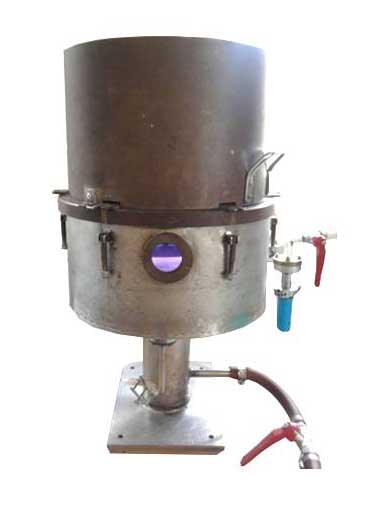
This equipment is suitable for surface treatment of polymeric foils as well as 3D products. Low-temperature radio-frequency plasma is generated between two brass circle electrodes, from which one is grounded and second is powered. The largest distance between two adjustable circle electrodes is 40 mm.
Specification:
Frequency: 13.56 MHz
Pmax : 600 W
Pressure: 0.1 kPa
Dielectric coplanar surface barier discharge plasma reactor
Faculty of Mathemathics and Physics, Comenius University, Bratislava, Slovakia
Institute of Electrical Engineering of Slovak Academy of Sciences
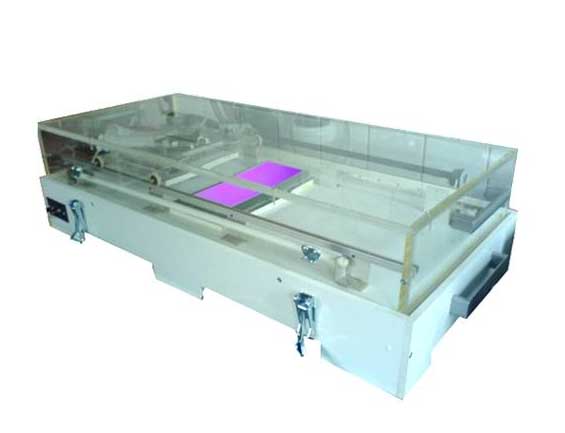
This equipment is used for surface treatment of foils. Macroscopic homogenously high-density plasma is generated under dynamic conditions at atmospheric pressure. Plasma is generated by two parallel banded system of electrodes (1-mm wide, 50 micrometers thick, with 0.5 mm spacing between the strips, made of Ag-paste) embedded in 96 % Al2O3-promotion of national purity.
Specification:
Frequency: 15 kHz
Um : 10 kV
Pmax : 450 W
Pressure: 100 kPa
Ultrasonic processor UP400S
Hielscher, Germany
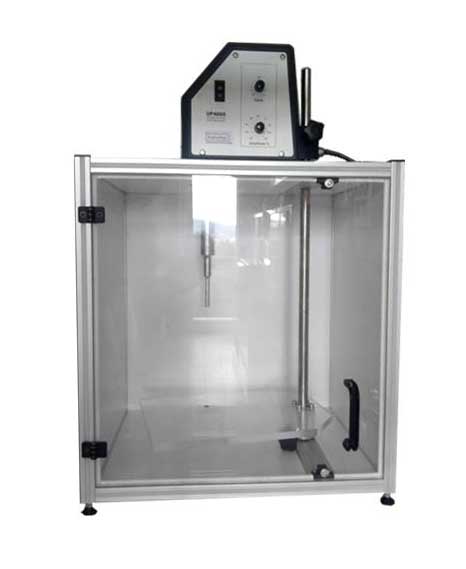
The ultrasonic processor UP400S is powerfull laboratory device for the generation of nano-size material slurries, dispersions and emulsions because of the potential in the deagglomeration and the reduction of primaries.
Specification:
Poweroutput: 400W
Working frequency: 24 kHz
Sonotrode H7 (diameter 7mm): Max amplitude: 175 µm
Acoustic power density: 300 W/cm2
Volumes: 10-250 ml

 contacts
contacts
